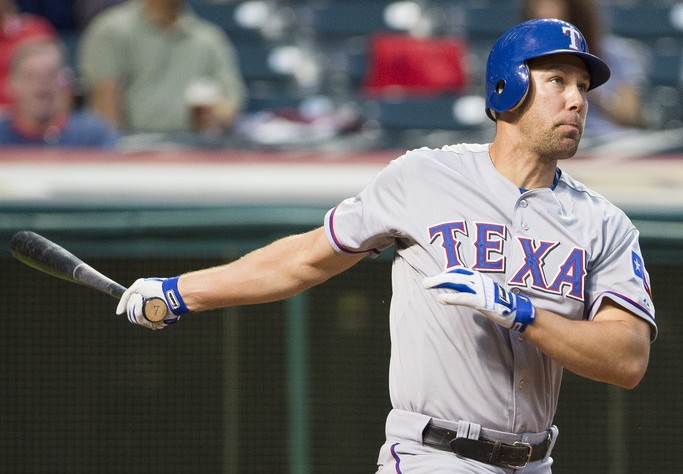 Even though the Indians increased payroll and made big splashes during last offseason’s free agency period, they’re still a small-to-mid-market team that needs to find value in places where other teams don’t. Chris Antonetti did that on Tuesday night with the free agent signing of David Murphy, a corner outfielder formerly with the Texas Rangers. The deal is for two years, $12 million, with a club option for a third year. Murphy was non-tendered by the Texas Rangers, thus making him a free agent.
Even though the Indians increased payroll and made big splashes during last offseason’s free agency period, they’re still a small-to-mid-market team that needs to find value in places where other teams don’t. Chris Antonetti did that on Tuesday night with the free agent signing of David Murphy, a corner outfielder formerly with the Texas Rangers. The deal is for two years, $12 million, with a club option for a third year. Murphy was non-tendered by the Texas Rangers, thus making him a free agent.
Most people in
Visions of the failed “Dellichaels” (or was it Michaelucci?) platoon are always cited as the reason why platoons don’t work. In theory, they should work out well, especially for a team with the financial standing of the Indians. Some don’t. The David Dellucci-Jason Michaels platoon was an example of one that did not work.
Most
There’s a very interesting dynamic at play between Murphy and Raburn. While Murphy was non-tendered by the Rangers for having a horrible year, Raburn is coming off a career year after having been signed to a minor league deal prior to Spring Training. The Indians front office is going on the assumption that Murphy will be better and that Raburn is unlikely to continue his production at the 2013 pace. Raburn doubled his wins above replacement player according to Fangraphs last season in his eighth season in the Majors. His slugging percentage was 113 points higher than his career slugging percentage in seven seasons with the Detroit Tigers.
Both players fit the platoon concept perfectly. Neither guy is a spectacular outfielder, but both of them are average to above average in right field. Also, the key numbers to look at are their splits against opposite-handed pitching.
Raburn 2013:
v. LHP: .308/.403/.617/1.020
v. RHP: .243/.320/.485/.806
Raburn career:
v. LHP: .263/.336/.492/.828
v. RHP: .255/.303/.411/.714
Murphy 2013:
v. RHP: .219/.286/.399/.685
v. LHP: .223/.270/.291/.562
Murphy career:
v. RHP: .280/.347/.469/.816
v. LHP: .259/.306/.350/.657
The Indians are able to get Murphy at a price below his true market value because he’s coming off of a down season. Murphy is a year removed from a career year, in which he batted .308/.380/.479/.859 and accumulated 3.9 WAR. Murphy has been an up and down player, but he has always been a good bat against righties. Furthermore, there’s reason to hope for a comeback season from Murphy. His batting average on balls in play was just .227 this past season, making him one of the unluckiest hitters in all of baseball. Most players fall between .290 and .310 in BABIP, so Murphy clearly has room to improve.
Also, another nice element about Murphy is that he doesn’t swing and miss much. Of players with 2500 or more plate appearances from 2008-13, Murphy’s swinging strike rate of 6.3 percent ranks 43rd out of 141 players. With a lot of guys that swing and miss on the roster, a guy who puts the ball in play like Murphy should be a nice complement to the rest of the offense.
As we’ve seen from Terry Francona, he likes to put his players in the best position to succeed and makes sure that his bench players are engaged and contributing. He’s the perfect manager for a situation like this. The Indians have Murphy and Raburn in the mix in right field, Nick Swisher can play right field, with Carlos Santana either playing first base or serving as the designated hitter, as well as Jason Giambi in the mix for DH at bats against right handed pitching.
Last month, Lewis Pollis, a contributor to Beyond the Box Score, Wahoos On First, and now ESPN Insider, wrote about how much a win really costs in free agency. Pollis took plenty of data and determined that a win costs about $7 million on the open market. The widely-accepted number had been much closer to $5 million. Pollis took some backlash, especially from Dave Cameron, whose work initially gave us the $5 million figure. Even if we assume that a win falls somewhere in between $5-7 million, a Murphy-Raburn platoon should, at a minimum, produce a two-win player for $8.25 million. That is decidedly better than market value and the Murphy-Raburn platoon has a decent shot to exceed three wins.
All around, this is a very good, low-risk move from Chris Antonetti. It gives the Indians some trade options with current personnel to improve other parts of the ballclub and it gives Francona plenty of flexibility, something that is essential with Jason Giambi likely securing a roster spot. The numbers would suggest that Murphy should not only bounce back, but thrive in a situation where he does not have to face lefties very often. Also, as we saw last season, the Indians coaching staff did well in helping players regain their old form.
This is one of the under the radar kind of moves that help a ballclub more than most people realize. If Murphy has a repeat of 2013, hindsight, as it always is, will be 20/20. But, there’s no guarantee that Ryan Raburn will produce the same and this gives the Indians an insurance policy at a reasonable cost. It’s yet another solid move by Antonetti that makes sense in this market and will hopefully pay off handsomely.